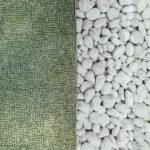Erosion by water
The erosion of concrete caused by hard suspended particles in flowing water presents a significant challenge in the design and maintenance of hydraulic infrastructure. This degradation mechanism is particularly critical for structures such as spillways, stilling basins, and dam outlets, where high-velocity flows and sediment-laden water are common.
Erosive processes are primarily governed by the mechanical interaction between suspended particles and the concrete surface. When carried by water at high velocities, these particles impact the surface repeatedly, resulting in localized material loss and surface degradation. The rate and severity of erosive wear are influenced by several factors, notably the hardness, angularity, and size of the suspended particles, as well as the velocity and turbulence intensity of the water flow (Monteiro et al., 2016).
The erosive wear rate is further determined by the relative hardness between the eroding particles and the concrete matrix. When the kinetic energy of the impacting particles exceeds a critical threshold, particularly in terms of shear stress, surface abrasion and material removal become increasingly pronounced (Rashidi et al., 2013). Empirical and numerical investigations have shown that erosion tends to escalate under conditions of prolonged exposure to high-energy collisions, making concrete surfaces in hydraulic structures especially vulnerable (Aziz et al., 2024).
Effective mitigation of such erosive damage requires a detailed understanding of particle dynamics and concrete surface resistance, alongside the implementation of protective measures such as surface coatings or the use of high-performance concrete mixtures.
Recommended test: ASTM C1138 – Standard Test Method for Abrasion Resistance of Concrete (Under Water Method)
ASTM C1138 is a standard test used to measure how well concrete resists abrasion under water, making it ideal for evaluating materials used in hydraulic structures like dams and spillways.
In this test, a concrete sample is placed in a container with water and steel balls. A rotating device moves the balls, causing them to hit and wear down the concrete surface.
The amount of concrete lost, measured in grams after set time periods (e.g., 72 hours), shows how resistant the concrete is to underwater abrasion.
Erosion by wind
The erosion of concrete surfaces due to windborne particulate matter has emerged as a significant concern in civil engineering, particularly in relation to the long-term durability and maintenance of structures situated in arid and semi-arid environments. In such regions, high-velocity winds frequently transport abrasive materials such as sand and fine dust, which contribute to progressive surface degradation of exposed concrete elements (Jia et al., 2021).
Wind erosion primarily operates through the mechanical action of repeated particle impacts. Over time, these impacts induce micro-scale surface damage, including pitting, micro-crack formation, and surface roughening, which cumulatively lead to a decline in both structural integrity and surface aesthetics. The abrasive interaction is characterized by the kinetic energy of particles striking the concrete surface, with erosion severity influenced by multiple variables, including particle size, angularity, hardness, and wind speed (Jia et al., 2021).
Experimental investigations-particularly wind tunnel studies-have provided valuable insights into erosion mechanisms. Finer particles tend to penetrate deeper into the surface pores of the concrete matrix, contributing to sub-surface degradation. In contrast, coarser and more angular particles are more likely to cause superficial abrasion and chipping, often resulting in greater mass loss and visible surface wear (Chen et al., 2021).
Understanding the influence of particle characteristics and environmental conditions is essential for developing mitigation strategies, such as the application of surface coatings, the use of erosion-resistant concrete mixtures, or optimized structural orientation to reduce direct exposure to prevailing winds.
Recommended test: ASTM C418 – Standard Test Method for Abrasion Resistance of Concrete by Sandblasting
ASTM C418 is a standard test used to check how well concrete resists surface wear by using sandblasting. It helps evaluate the surface hardness and abrasion resistance of concrete.
In this method, sand is blasted onto the concrete surface at a specific angle, pressure, and for a set time. After the test, the depth or weight of material removed is measured.
References
- Monteiro, O., Murugesan, S., Suresh, R., & Khabashesku, V. N. (2016). Corrosion- and erosion-resistant metal matrix nanocomposite coatings for the oil and gas industry. SPE International Oilfield Corrosion Conference and Exhibition. https://doi.org/10.2118/179933-ms
- Aziz, Z. A., Hilo, A. N., & Al-Gasham, T. S. (2024). Review of erosion causes and important factors on the abrasion resistance of concrete. Wasit Journal of Engineering Sciences, 12(4), 113-121. https://doi.org/10.31185/ejuow.vol12.iss4.585
- Rashidi, A., Paknezhad, M., Mohamadi-Ochmoushi, M. R., & Moshrefi‐Torbati, M. (2013). Comparison of erosion, corrosion and erosion-corrosion of carbon steel in fluid containing micro- and nanosize particles. Tribology – Materials, Surfaces &Amp; Interfaces, 7(3), 114-121. https://doi.org/10.1179/1751584x13y.0000000039
- Jia, Y., Pei, Y., & Xie, Z. (2021). Experimental study on wind erosion of concrete building surface in wind-sand environment. E3S Web of Conferences, 272, 01001. https://doi.org/10.1051/e3sconf/202127201001
- Chen, S., Tang, R., Zhang, L., & Liao, B. (2021). Numerical investigation of wind erosion to the grooved concrete wall surface under a wind‐blown sand movement. Advances in Materials Science and Engineering, 2021(1). https://doi.org/10.1155/2021/1604186








